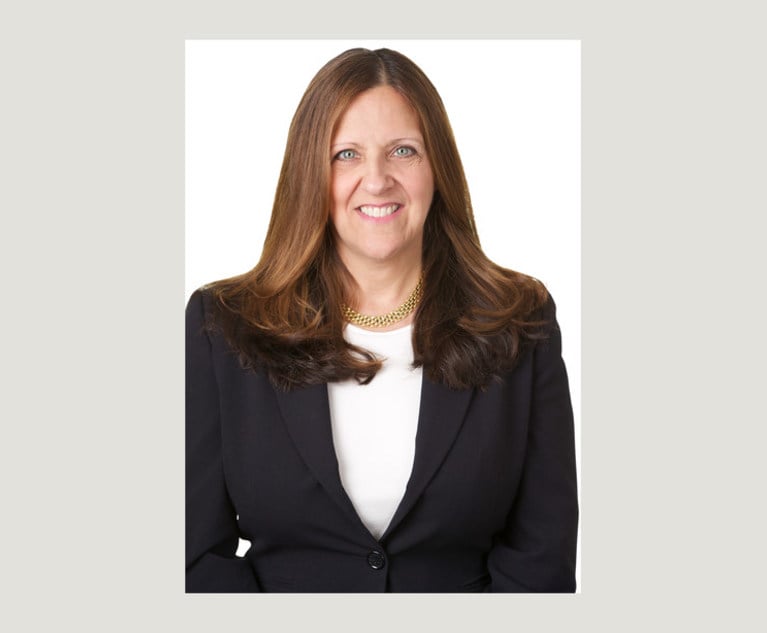 Credit: LOVE YOU/Shutterstock.com
Credit: LOVE YOU/Shutterstock.comEqual Pay Audits: Essential Action in Light of NJ's Broad Equal Pay Act
The Diane B. Allen Equal Pay Act went into effect in New Jersey on July 1, 2018. Employers should take a proactive approach to determine if they are in compliance with the act before they are faced with costly litigation.
May 23, 2019 at 10:30 AM
10 minute read
The Diane B. Allen Equal Pay Act (EPA or “the Act”), went into effect in New Jersey on July 1, 2018. N.J.S.A. 10:5-12(t). The EPA amends the already expansive New Jersey Law Against Discrimination (LAD). The EPA was named for recently retired New Jersey State Senator Diane B. Allen, who experienced wage discrimination herself while working as a TV anchor.
The EPA is unprecedented in breadth and scope in pay disparity claims. Like the LAD, the EPA applies to virtually all public and private employers in New Jersey regardless of size or industry. N.J.S.A. 10:5-5(f). The Act also applies to all protected classes identified in the LAD, including race, creed, color, national origin, nationality, ancestry, age, marital status, civil union status, domestic partnership status, affectional or sexual orientation, genetic information, pregnancy, sex, gender identity or expression, disability or atypical hereditary cellular or blood trait of any individual, or liability for service in the armed forces. N.J.S.A. 10:5-12(t).
Under the Act, it is unlawful for an employer to pay its employees who are members of a protected class at a rate of compensation, including benefits, that is less than employees who are not members of the protected class for substantially similar work. Id. However, compensation, including benefits are terms that are not defined. Based on interpretations of equal pay statutes from other jurisdictions and the Equal Employment Opportunity Commission (EEOC), in addition to salary, other types of compensation and benefits will likely include overtime, commissions, bonuses, profit sharing, deferred compensation, paid time off, expense accounts, car and gas allowances, phone allowances, housing allowances, retirement plans, insurance, and other benefits.
An aggrieved employee may bring a lawsuit if the employee shows he or she is: (1) a member of a protected class; (2) paid less than an employee who is not in the same protected class; and (3) performs work that is “substantially similar” to employees not in the same protected class. Once the employee shows the above three elements, the burden then shifts to the employer to justify the differential in pay.
To ensure compliance with the EPA and to remedy pay inequities proactively, many employers are now performing internal Equal Pay Audits (“Audits”). For numerous reasons, such as confidentiality/privilege concerns and time constraints of internal staff, employers might engage outside counsel to conduct the Audit. Outside counsel can devote time to conducting the Equal Pay Audits that in-house employees might not have, especially if the employer has numerous employees or locations to audit. Additionally, employers might find it easier to avoid internal dynamics and to accept recommendations suggested by outside, independent counsel.
Equal Pay Audits can be structured to: (1) determine pay disparities among employees doing comparable work; (2) evaluate whether any lawful explanations exist to support those disparities; (3) identify any weaknesses in the organization's systems that should be addressed to prevent potential pay disparity claims; and (4) implement procedures to remediate those weaknesses and any unlawful pay disparities.
|Pre-Audit: Engagement Agreement, Privileges, Scope
Prior to commencing the Audit, counsel should have a clear Engagement Agreement establishing the structure of the Audit, the expected scope, and whether the Audit will be performed on a flat fee or hourly basis. Conducting Audits in separate phases (as detailed below) can be an effective way to manage the process. If the purpose of the Audit is to facilitate the rendering of legal advice, it should be designated “Attorney-Client Privilege” along with other documents prepared. Another consideration is whether the Audit is in anticipation of litigation and should be designated “Attorney Work Product.”
Given the six-year period set forth in the Act, consider how far back to look. Some employers will want to focus on the present, whereas others may want to go back further to assess disparities. While there are arguments as to whether an aggrieved employee could seek redress for conduct that occurred before the enactment of the EPA, at least one federal court has determined that the Act should not be applied retroactively. Perrotto v. Morgan Advanced Materials, 2019 U.S. Dist. LEXIS 6745, 2019 WL 192903 (D.N.J. Jan. 15, 2019).
Prior to commencing the Audit, the auditors should establish a direct line of communication with the in-house counsel, human resources, or other representative(s) who can provide all compensation, benefits and protected class information for employees, facilitate personnel interviews, and answer questions throughout the course of the Audit. It is helpful to have an internal manager of the project to intervene as needed in case staff members are not being responsive to outside auditors.
|Audit Phase One
During Phase One of the Audit, it should be determined which employees are to be included in the Audit. Employees whose salaries are dictated by collective bargaining agreements, statutes or resolutions may potentially be analyzed differently.
Information/Documents to be requested include: information on structure, supervision and hierarchy (organizational charts); employee names; job title; job code/grade; division/department/business unit; work location; job functions (job descriptions); full-time/part-time/temporary status; exempt/non-exempt status (hourly/salary); dates of employment; dates in current role; amounts of salary, bonuses, commissions, overtime pay, shift differential pay and any other forms of compensation/benefits; and whatever protected class information is available (i.e., race/nationality, age, gender, etc.). The auditors should inquire as to whether there are any “seniority or merit systems” and obtain documents reflecting same. It would also be helpful to gather any documents that address compensation, raises, bonuses and commissions. If there are variations in benefit distribution, these documents should be obtained as well.
It is key during Phase One of the Audit to gather information regarding each employee's functional job duties. Use of Audit questionnaires can be considered. In some instances, they could be helpful. In others, the questionnaires might create too much of a delay or result in data that may not be sufficiently robust and/or create privilege implications. Requests for job descriptions will also aid in understanding the functional duties of certain positions.
If accurate and current job descriptions do not exist or are outdated, the auditors should meet with department heads or those who know best the work that employees are actually performing to assess substantially similar work. Meetings create accountability and often result in effective information gathering. Prior to each meeting, the employer representative should prepare, or have their employees prepare, a description of each employee's day to day job duties, to be reviewed and expanded upon during the audit meetings. Meetings can be particularly helpful in the public sector, where civil servant job titles and descriptions are not entirely representative of the duties an employee actually performs on a daily basis. As such, requests for “functional” job titles and job descriptions are essential.
Accessibility to the protected class information may prove challenging in itself. Employers with 100 or more employees, and/or that perform federal contract work, have reporting obligations via form EEO-1 to the EEOC pursuant to Title VII of the Civil Rights Act of 1964. There are now two components to the EEO reporting obligations. Component 1 seeks demographic data on race, gender and ethnicity by job category, and employers must file it annually by May 31. 42 U.S.C. §2000e-8. A new Component 2 will now require certain pay data by Sept. 30, 2019.
The guidelines for EEO Reports suggest that self-identification is the preferred method for identifying race and ethnicity, however, employees cannot be required to make such disclosures. Employment records and observation are suggested as alternative methods of identification. There are some protected categories that may not be voluntarily disclosed by employees, such as age, disability and sexual orientation. If employers are not otherwise aware of protected classes, those classes should not be sought out for purposes of the Audit.
|Audit Phase Two
During Phase Two of the Audit, a comprehensive review and analysis of all information gathered in Phase One is necessary to identify compensation disparities based on employees performing substantially similar duties. During this phase, additional interviews or information requests might be necessary. Also, it may be helpful to select employees to be interviewed to ensure full disclosure of information needed for analysis. A random selection may work for certain Audits. In others, it may be preferred to interview only employees who are in positions identified as receiving disparate pay.
|Audit Phase Three
During Phase Three, if pay disparities were revealed during Phase Two, the auditors will need to evaluate more as to the justifications and consider whether:
- The differential is pursuant to a seniority system, a merit system, or the existence of legitimate, bona fide factors other than the characteristics of members of a protected class, such as training, education, experience, quantity of production, or quality of production;
- The factors are not based on, and do not perpetuate, a differential in compensation based on sex or any other characteristic of members of a protected class;
- Each of the factors is applied reasonably;
- One or more of the factors accounts for the entire wage differential; and
- The factors are job-related with respect to the position at issue and based on a legitimate business necessity.
N.J.S.A. 10:5-12(t) (emphasis added).
A legitimate business necessity does not apply if alternate business practices would serve the same business purpose without producing the wage differential. Also, the act requires that “comparisons of wage rates shall be based on the wage rates in all of an employer's operations or facilities.” Id. (Emphasis added.) This strikingly broad language does not limit itself to wage rate comparisons within a specific geographic area.
During this Phase, the auditors should analyze an employee's level of education (degrees), prior work experience, special licenses/certifications, and performance ratings by reviewing resumes, job applications, performance reviews. It may also be necessary to conduct further interviews.
The full scope of the Phase Three assessment depends on whether the auditors may be asked to provide recommendations or to report on the findings to have another counsel make recommendations. If pay disparities are discovered for which no lawful justifications exist, the Audit will reveal those disparities so employers can make pay adjustments that increase the compensation of the lower paid employees.
|Conclusion
In enacting the EPA, New Jersey is on the forefront of a wave of equal pay initiatives occurring across the country. There will undoubtedly be future court decisions to help shed light on certain provisions. Employers should take a proactive approach to determine if they are in compliance with the Act before they are faced with costly litigation. Engaging legal counsel to conduct an Equal Pay Audit, and training those involved on hiring and compensating professionals are ways that employers can reduce their exposure under the Act and rectify employee pay inequities.
Kirsten Scheurer Branigan is the owner of KSBranigan Law, in Montclair. Carole Lynn Nowicki is a partner at the firm. Alternative dispute resolution, workplace investigations, employment compliance and audits, and training are among the firm's practices areas. Both Branigan and Nowicki are arbitrators with the American Arbitration Association.
|This content has been archived. It is available through our partners, LexisNexis® and Bloomberg Law.
To view this content, please continue to their sites.
Not a Lexis Subscriber?
Subscribe Now
Not a Bloomberg Law Subscriber?
Subscribe Now
NOT FOR REPRINT
© 2024 ALM Global, LLC, All Rights Reserved. Request academic re-use from www.copyright.com. All other uses, submit a request to [email protected]. For more information visit Asset & Logo Licensing.
You Might Like
View All
For Lawyers, the 'Work' of Making an Impact Does Not Have to Happen in a Courtroom. Laura E. Sedlak Says

Doing the Right Thing in the Pursuit of Justice Requires Guts, Says Lyndsay Ruotolo

One Can be Most Impactful When Their Pursuits Are Driven by Their Concerns and Passions, Says Sherilyn Pastor

As a Lawyer, You Have a Powerful Way to Make an Impact, Says Mary Frances Palisano
Trending Stories
- 1Call for Nominations: Elite Trial Lawyers 2025
- 2Senate Judiciary Dems Release Report on Supreme Court Ethics
- 3Senate Confirms Last 2 of Biden's California Judicial Nominees
- 4Morrison & Foerster Doles Out Year-End and Special Bonuses, Raises Base Compensation for Associates
- 5Tom Girardi to Surrender to Federal Authorities on Jan. 7
Who Got The Work
Michael G. Bongiorno, Andrew Scott Dulberg and Elizabeth E. Driscoll from Wilmer Cutler Pickering Hale and Dorr have stepped in to represent Symbotic Inc., an A.I.-enabled technology platform that focuses on increasing supply chain efficiency, and other defendants in a pending shareholder derivative lawsuit. The case, filed Oct. 2 in Massachusetts District Court by the Brown Law Firm on behalf of Stephen Austen, accuses certain officers and directors of misleading investors in regard to Symbotic's potential for margin growth by failing to disclose that the company was not equipped to timely deploy its systems or manage expenses through project delays. The case, assigned to U.S. District Judge Nathaniel M. Gorton, is 1:24-cv-12522, Austen v. Cohen et al.
Who Got The Work
Edmund Polubinski and Marie Killmond of Davis Polk & Wardwell have entered appearances for data platform software development company MongoDB and other defendants in a pending shareholder derivative lawsuit. The action, filed Oct. 7 in New York Southern District Court by the Brown Law Firm, accuses the company's directors and/or officers of falsely expressing confidence in the company’s restructuring of its sales incentive plan and downplaying the severity of decreases in its upfront commitments. The case is 1:24-cv-07594, Roy v. Ittycheria et al.
Who Got The Work
Amy O. Bruchs and Kurt F. Ellison of Michael Best & Friedrich have entered appearances for Epic Systems Corp. in a pending employment discrimination lawsuit. The suit was filed Sept. 7 in Wisconsin Western District Court by Levine Eisberner LLC and Siri & Glimstad on behalf of a project manager who claims that he was wrongfully terminated after applying for a religious exemption to the defendant's COVID-19 vaccine mandate. The case, assigned to U.S. Magistrate Judge Anita Marie Boor, is 3:24-cv-00630, Secker, Nathan v. Epic Systems Corporation.
Who Got The Work
David X. Sullivan, Thomas J. Finn and Gregory A. Hall from McCarter & English have entered appearances for Sunrun Installation Services in a pending civil rights lawsuit. The complaint was filed Sept. 4 in Connecticut District Court by attorney Robert M. Berke on behalf of former employee George Edward Steins, who was arrested and charged with employing an unregistered home improvement salesperson. The complaint alleges that had Sunrun informed the Connecticut Department of Consumer Protection that the plaintiff's employment had ended in 2017 and that he no longer held Sunrun's home improvement contractor license, he would not have been hit with charges, which were dismissed in May 2024. The case, assigned to U.S. District Judge Jeffrey A. Meyer, is 3:24-cv-01423, Steins v. Sunrun, Inc. et al.
Who Got The Work
Greenberg Traurig shareholder Joshua L. Raskin has entered an appearance for boohoo.com UK Ltd. in a pending patent infringement lawsuit. The suit, filed Sept. 3 in Texas Eastern District Court by Rozier Hardt McDonough on behalf of Alto Dynamics, asserts five patents related to an online shopping platform. The case, assigned to U.S. District Judge Rodney Gilstrap, is 2:24-cv-00719, Alto Dynamics, LLC v. boohoo.com UK Limited.
Featured Firms
Law Offices of Gary Martin Hays & Associates, P.C.
(470) 294-1674
Law Offices of Mark E. Salomone
(857) 444-6468
Smith & Hassler
(713) 739-1250






